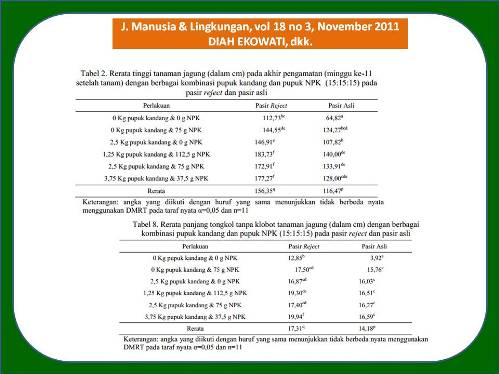
PERTUMBUHAN TANAMAN JAGUNG (Zea mays, L.) VARIETAS BISI-2 PADA PASIR REJECT DAN PASIR ASLI DI PANTAI TRISIK KULONPROGO (The Growth of Maize Crop (Zea mays L.) BISI-2 Variety on Rejected and non Rejected Sand at Pantai Trisik Kulon Progo)
Diah Ekowati(1*), Mochamad Nasir(2)
(1) Fakultas Biologi, Universitas Gadjah Mada Yogyakarta
(2) Fakultas Biologi, Universitas Gadjah Mada Yogyakarta
(*) Corresponding Author
Abstract
ABSTRAK
Lahan pasir di pesisir Kabupaten Kulon Progo yang sekarang ditanami berbagai komoditi pertanian seperti cabe, semangka, jagung akan ditambang untuk diekstrak mineral besinya. Rencananya setelah diekstrak mineral besinya, pasir sisa (pasir reject) akan dikembalikan sebagai material reklamasi untuk dapat ditanami kembali. Tujuan penelitian ini adalah untuk mengetahui pengaruh perbedaan media tanam berupa pasir reject dan pasir asli serta dosis pupuk kandang dan pupuk NPK pada pertumbuhan tanaman jagung (Zea mays L.) varietas BISI-2 di Pantai Trisik Kulon Progo. Dosis pupuk yang diberikan ialah 0 Kg pupuk kandang dan 0 g NPK (kontrol); 0 Kg pupuk kandang dan 75 g NPK; 2,5 Kg pupuk kandang dan 0 g NPK; 1,25 Kg pupuk kandang dan 112,5 g NPK; 2,5 Kg pupuk kandang dan 75 g pupuk NPK; dan 3,75 Kg pupuk kandang dan 37,5 g NPK. Parameter yang diamati pada penelitian ini adalah tinggi tanaman, jumlah daun, berat kering tajuk, waktu berbunga, jumlah tongkol, berat tongkol, panjang tongkol, dan diameter tongkol. Data yang diperoleh diuji dengan analisis variansi (Anava) dan uji lanjut dengan Duncan’s Multiple Range Test (DMRT). Hasil penelitian menunjukkan bahwa rerata tinggi, jumlah daun, berat kering tajuk, jumlah tongkol, berat tongkol, panjang tongkol dan diameter tongkol tanaman jagung pada pasir reject lebih tinggi daripada pasir asli sedangkan rerata waktu berbunga tanaman jagung pada pasir reject lebih lama daripada pasir asli. Selain itu, hasil penelitian menunjukkan bahwa pertumbuhan vegetatif tanaman jagung paling optimal diperoleh pada dosis 1,25 Kg pupuk kandang dan 112,5 g pupuk NPK sedangkan pertumbuhan generatif tanaman jagung paling optimal diperoleh pada dosis 3,75 Kg pupuk kandang dan 37,5 g pupuk NPK.
ABSTRACT
Sand in the coastal District of Kulon Progo land which is now planted with various agricultural commodities such as pepper, watermelon, corn, will be mined to extract its iron minerals. In the mining plan, after the iron mineral is extracted, the remaining sand (reject sand) will be returned as reclaimed material to be replanted. The aim of this study was to investigate the effect of different growth media called rejected and non rejected sand also fertilizer dossage of manure and NPK on the growth of maize crop (Zea mays L.) BISI-2 variety at Pantai Trisik Kulon Progo. Fertilizers dossage that used in this study were 0 Kg manure and 0 g NPK (control), 0 Kg manure and 75 g NPK, 2,5 Kg manure and 0 g NPK, 2,5 Kg manure and 112,5 g NPK, 2,5 Kg manure and 75 g NPK, and 3,75 Kg manure and 37,5 g NPK. The parameters measured including plant height, number of leaves, dry weight of shoot, flowering time, number of cob, weight of cob, lenght of cob, and diameter of cob. The data collected were analyzed with Analysis of variance (Anova) and for the advance test Duncan’s Multiple Range Test (DMRT) was used. The results of this study showed that the avarage of plant height, number of leaves, dry weight of shoot, number of cob, weight of cob, lenght of cob, and diameter of cob of maize crop (Zea mays L.) BISI-2 variety on reject sand was higher than non rejected sand but the average of flowering time of maize crop (Zea mays L.) BISI-2 variety on rejected sand is longer than non rejected sand. In addition, the result of this study showed that the optimum vegetatif growth of maize crop was gained on dossage of 1,25 Kg manure and 112,5 g NPK but the most generatif growth of maize crop gained on dossage 3,75 Kg manure and 37,5 g NPK.
Full Text:
Artikel lengkap (PDF) (Bahasa Indonesia)Article Metrics
Refbacks
- There are currently no refbacks.
Copyright (c) 2017 Jurnal Manusia dan Lingkungan







